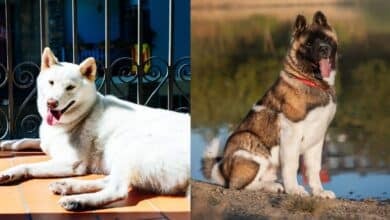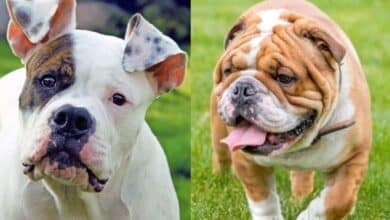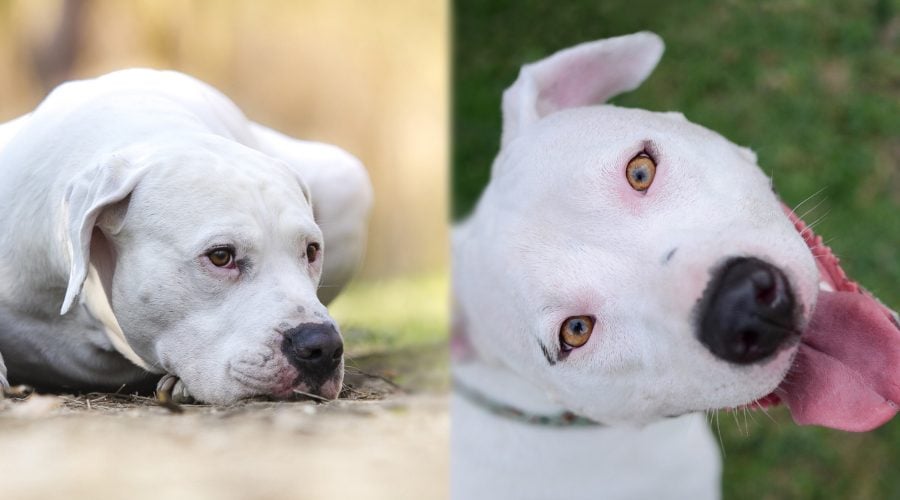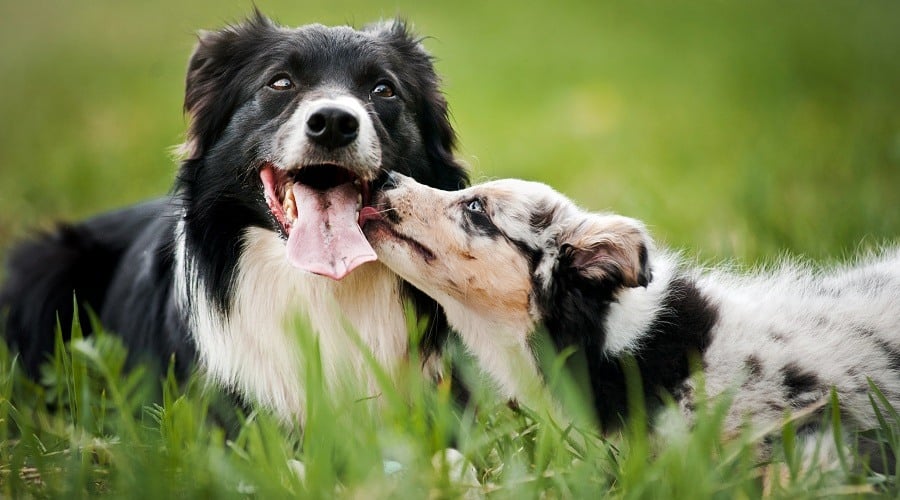Alaskan Malamute vs. Siberian Husky: Breed Differences & Similarities
When you purchase through links on our site, we may earn a commission. Here’s how it works.
Comparing the Alaskan malamute vs. the Siberian Husky when considering your next puppy? Do you know what the differences and similarities are? If not read on, as we dive into the detail of both of these historic breeds. These two breeds are as old as time, and as the famous saying goes “respect your elders,” because these two valiant dudes definitely deserve (and command!) your respect. Each one is as majestic and beautiful as the other, and although it may come as a surprise to some, they are both very sweet-natured and loving towards their family pack. In fact, they are commonly mixed together as well, producing offspring called the Alusky.
Both of these breeds are very energetic dogs from a working background and as such they must get the exercise they need, and they need much, much more than your average pooch. The Alaskan Malamute was originally used to pull heavy sleds due to his sheer strength, and the Siberian Husky was needed for his supersonic speed.
Both are similar in appearance and most definitely could be brothers, with the Alaskan Malamute being the taller and chunkier sibling! The Husky is a bit more jovial than the Malamute, but the Malamute makes for a better guard dog. The Alaskan Malamute requires a bit more grooming compared to the Husky, but the Husky is cheaper to buy.
So, whether you are trying to decide between the two breeds, or you’re just here to increase your canine knowledge, let’s break the ice and dive straight into the details of their differences and similarities.
Table of Contents
Breed Comparison
- Height23-28 Inches
- Height20-23.5 Inches
- Weight65-100 Pounds
- Weight35-65 Pounds
- TemperamentAffectionate, Loyal, Playful
- TemperamentMischievous, Loyal, Loving
- EnergyHigh
- EnergyHigh
- HealthAverage
- HealthAbove Average
- Lifespan10-14 Years
- Lifespan12-14 Years
- Price$1,500-$2,000
- Price$850-$1,500
Breed History
Both of these beautiful breeds share a similar history and purpose, but with a geographical twist.
Alaskan Malamute
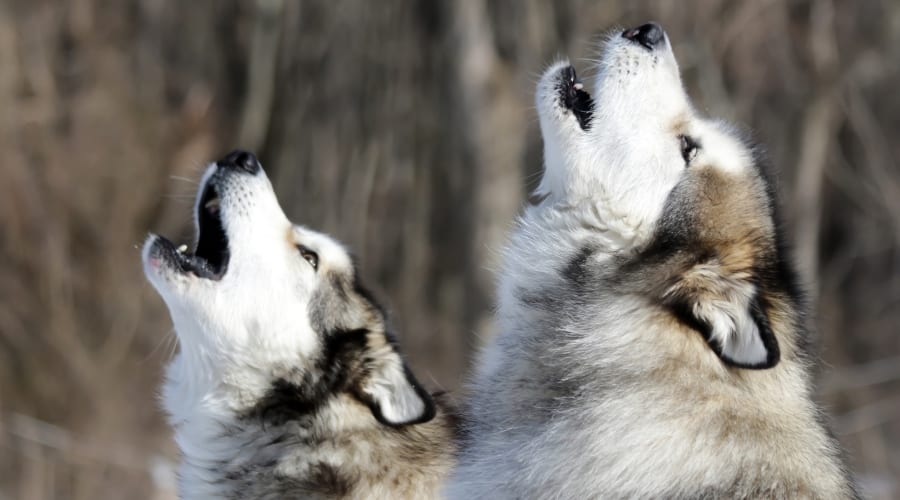
The Alaskan Malamute is the original freight machine. He was developed over time by the Mahlemut Tribe in North-Western Alaska more than 4,000 years ago. He was developed as a pack dog designed to pull heavy weight over large distances. They were also designed to be kept as companion dogs for the whole family after a day at work.
In recent times, the Alaskan Malamute is becoming more recognized in popular culture. In 1984 he was one of four pure-bred dogs to feature on US Stamps to celebrate the American Kennel Club’s (AKC) centennial anniversary. Then, in 2010 the Malamute was promoted to the rank of the official state dog of Alaska due to a petition started by a group of schoolchildren. Today he is ranked as the 58th most popular dog in America by the AKC.
Siberian Husky
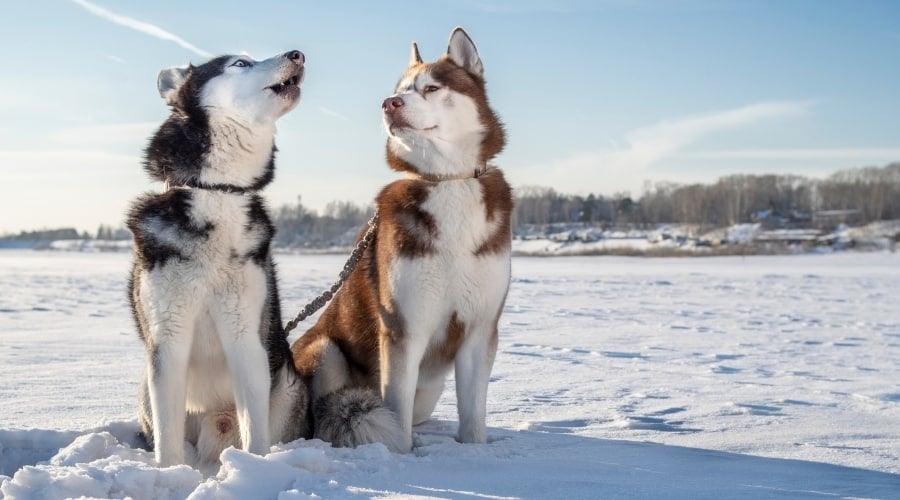
The Siberian Husky is the original race car bred by the Chukchi Tribe in Russia thousands of years ago. They were designed to haul light loads over vast expanses of land at the speed of light (or at least as fast as they could), without tiring too easily. Similar to the Malamute, the Husky was also favored as a family dog who brought companionship for the whole family.
The Siberian Husky rose to fame when, in 1925, an outbreak of the deadly Diphtheria broke out, and a pack of Huskies ran 658 miles across frozen land in five and a half days to deliver a lifesaving antidote. Balto, who was the leading dog in the most important final stretch, is one of the most honored and celebrated dogs of all time. Since then the Husky has been amongst the most popular family dogs in America, ranked by the AKC as the 14th most popular breed.
Because of their popularity, they have been used in several cross breed efforts with other purebred dogs. Some examples of these husky mixed breed dogs are the Pomsky and the Horgi, which is a mix between a Siberian Husky and a Welsh Corgi.
Appearance
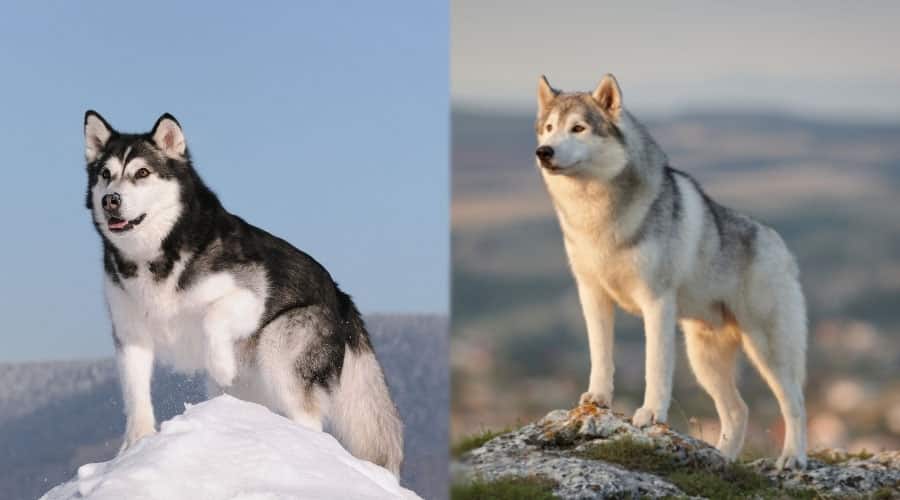
There is no competition when it comes to size between these two wolf-like dog breeds, the Malamute wins paws down. The Malamute weighs, on average, up to 100 pounds, and at 35% less, the Husky up to 65 pounds. The Malamute also measures up to 28 inches at the withers (paw to shoulder), compared to the Husky’s 23.5 inches.
As the Malamute is a large breed and the Husky is a medium-sized breed, this is a significant factor to take into consideration if you are choosing between the two. Being a colossal canine with oodles of brute strength, the Malamute will probably not appreciate the apartment lifestyle.
Both the breeds are similar in appearance when it comes to their face and body; not dissimilar to a wolf, but much more approachable! They both have medium-length straight hair, but the Malamute’s coat is slightly denser than the Husky, making him look that little bit fluffier. Malamutes can come in black, light gray, and some shades of red, while Huskies come in red, black, sable, agouti, and white.
Temperament
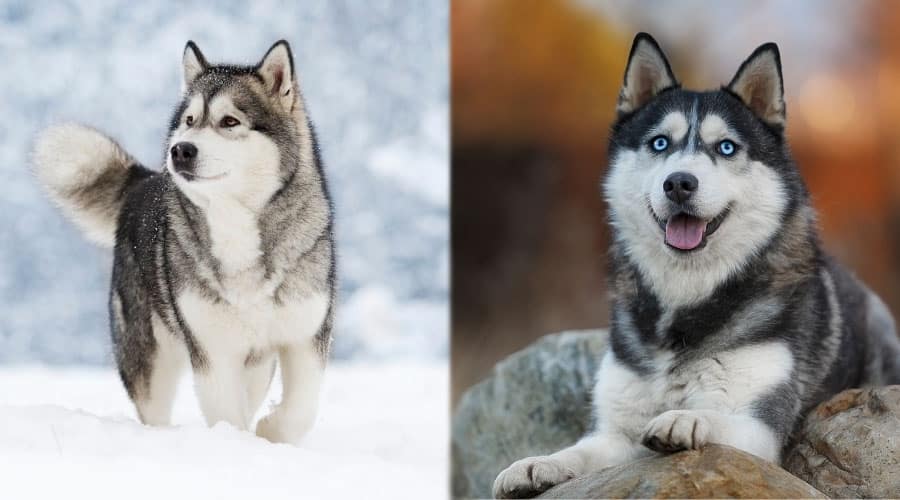
Both the Alaskan Malamute and the Siberian Husky were bred to work in packs of dogs and live alongside their masters and family. Both of these pups are very loving and affectionate with their pack, and once they have settled down for the evening after a fun-filled day they will jump on the sofa with you and demand attention, strokes, and cuddles.
However, the Malamute tends to be more aloof with strangers or those he hasn’t accepted as one of the pack yet. On the other hand, the Husky is particularly sociable and will accept other humans and animals alike. It is for this reason the Husky has been known to suffer from separation anxiety and does not like to be left at home on his own for too long.
Due to this difference in their sociality, the Malamute has increased guarding tendencies compared to the Husky, and therefore Malamute’s can often make good guard dogs. The Malamute has a high prey drive and a low tolerance for other animals, particularly other dogs, whereas the Husky also has a high prey drive but is tolerant and social with other animals. For this reason, the Siberian Husky rarely makes a good guard dog, as he thinks everyone just wants to play, which is great for the family but not much of a deterrent for would-be intruders. So, this makes them a more suitable pet for a young family or a family with other pets.
Another difference between the two breeds is the Husky tends to be more vocal than the Malamute. Both breeds howl and bark, but the Husky is said to be chattier. A great example of this is the internet sensation Mishka the Husky, sadly she passed over the rainbow bridge recently, but she is the perfect example of how chatty the Husky can be. She mimicked her family when they spoke to her, and she has even said “I love you” and “I want waffles”, check her out on YouTube to see her hilarious videos!
Both the Malamute and the Husky are considered to be the ‘Houdini of Hounds’; if your house and yard are not dog-proof, they will escape. And trust me when I say they won’t just have a little mooch about the estate, both will run for miles and miles on end. After all, that is what they were originally bred to do! So, if you can’t dog-proof your house, or fence them into your yard then neither of these pooches is the one for you. The Husky can easily jump a 6-foot fence! Additionally, it is recommended that neither of these guys is let off the leash when in public as they will do a disappearing act.
Another trait they have as an inherent escape artist is that both breeds dig big holes and your garden will be full of dirt mounds when they ‘go for gold’ (probably not actual gold!) If you do find them digging in your garden then it is likely they either want to escape or they are just bored. This ‘huge hole’ trait is unique to these two breeds. Most dogs can be diggers, but these two are the JCBs of canine excavators.
Energy
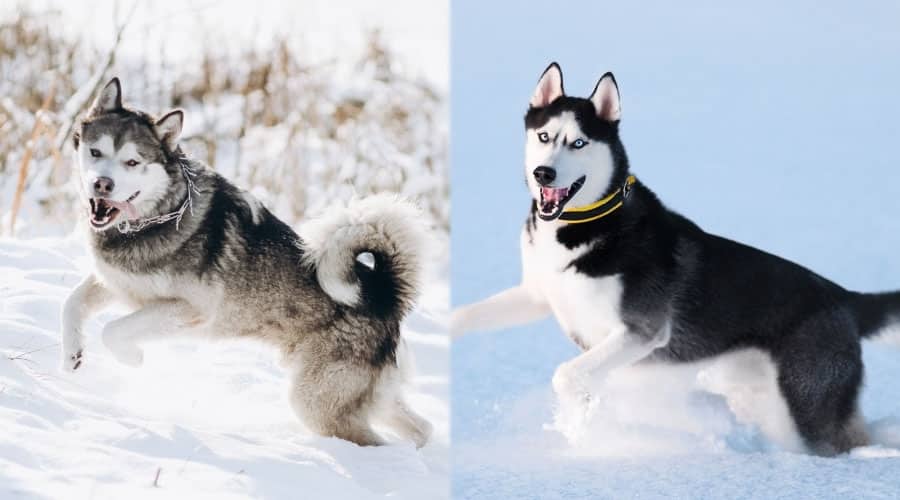
When it comes to exercise these guys are very similar – they both need lots and lots of it! They will both need at least 90 minutes of activity per day, but this shouldn’t just be a 90-minute walk, they need to burn off some serious steam with intense exercise. This could be tug-of-war, frisbee, or even dog agility courses to name but a few.
They also both benefit from being off-leash and allowed to run to their heart’s content given that they are both sled dogs! It will need to be somewhere fenced off, so if you have a large enclosed yard then this would be perfect. If you haven’t got a large yard do not fear, there are plenty of free doggy parks or enclosed fields you can rent for an hour, solely for this purpose!
They are both working dogs who were built to run miles at a time without tiring, and this want for work is innate and can never be trained out of them. If they do become bored, they will destroy anything they can get their paws on. This is the main reason Malamutes and Huskies are put up for rehoming more so than the average breed, simply because their owners completely underestimate their need for exercise. If you can’t give them the activity they need then neither of these breeds are for you.
Training
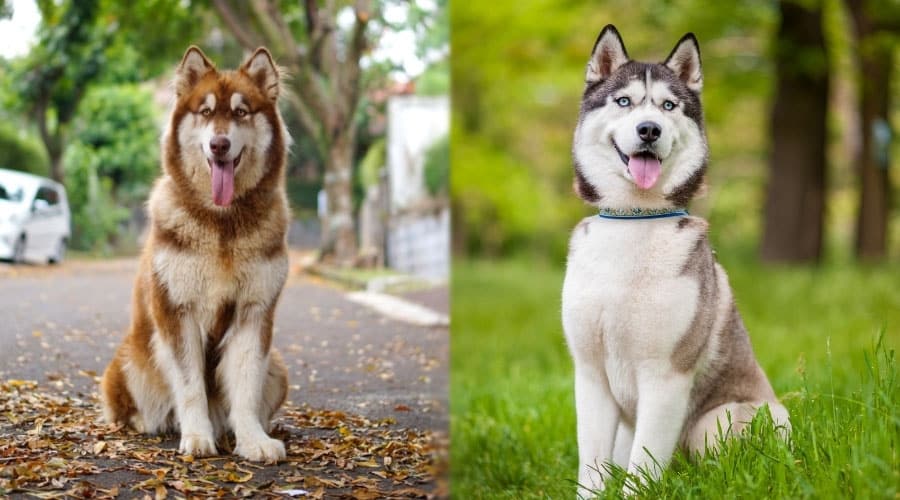
Both the Malamute and the Husky are intelligent breeds, which is great as it means that they pick up commands quickly and as long as you are consistent, they will stick to them too!
Obedience training is the key with these guys, so make sure you are dominant and in charge. Having a strong pack mentality means they require a clear pack leader, and if you don’t assume this position or they don’t think you have earned this position, they will decide to become the leader themselves. Not only does this lead to behavioral issues, but it can also lead to an unhappy household, so it is vital you get the pecking order established immediately.
If you plan to crate train, make sure you get the right crate for this breed as Huskies need a medium-sized crate and Malamutes likely need an XXL crate if you get a giant Malamute.
It is also important to socialize these guys from an early age. Socialization is important because it teaches your pup that other humans and other animals aren’t a threat and that there is no need to protect the pack from all strangers. By making every encounter a pleasant one through positive reinforcement training, your pooch will grow up to be a well-mannered and happy doggo. This is slightly more important for the Malamute as his barking and guarding tendencies are slightly higher than the Husky, and the Malamute is less tolerant of other dogs. If you want to overcome this in your Malamute, then socialization training is the answer.
The Malamute is said to be a head-strong dog, much more than the Siberian Husky, so you may experience more difficulty training the Malamute than the Husky. With that being said, if you are struggling with training, either due to stubbornness or something else, then it is always a good idea to take them to obedience training classes where a dog behavioral therapist can assess your pup and assist you in the process.
Health
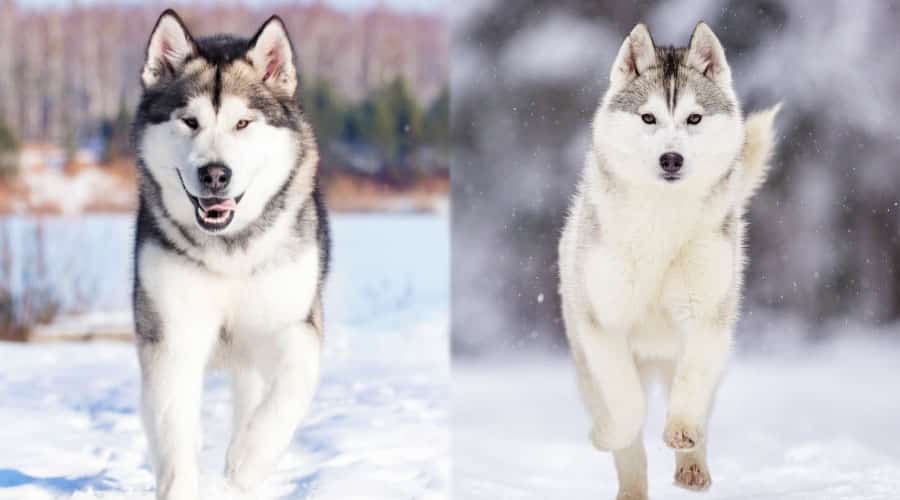
The Alaskan Malamute and the Siberian Husky have similarities and differences when it comes to their health. Generally, however, the Siberian Husky tends to be healthier than the Alaskan Malamute, as the Malamute’s health tends to decline sooner than the Husky.
The National Breed club recommends both dogs are tested for Hip Dysplasia, which is an abnormality in the formation of the joints which can cause lameness in the limbs or painful arthritis of the joints. The Club also recommends an Ophthalmologist evaluation, which covers many eye diseases, such as Progressive Renal Atrophy, Cataracts, and Day Blindness.
On top of those issues, the Alaskan Malamute is also tested for Polyneuropathy, which is a neuro disease that affects the nervous system. There are many symptoms you can look out for, such as the loss of use in their limbs, lack of coordination, intolerance to exercise, and loss of muscle mass to name but a few. The symptoms of this often occur in pups between the ages of 7 to 18 months. A reputable breeder will carry out a genetic test on the pup to see whether he has got it.
Additionally, the Malamute is also more at risk of suffering from Von Willebrand’s disease, which is caused by a deficiency in the number of particular platelets in his blood, this means his blood is unable to clot. Chondrodysplasia, also known as Dwarfism, can be found in the Malamute; however, this is something that can normally be spotted in the first few months of the pup’s life.
Nutrition
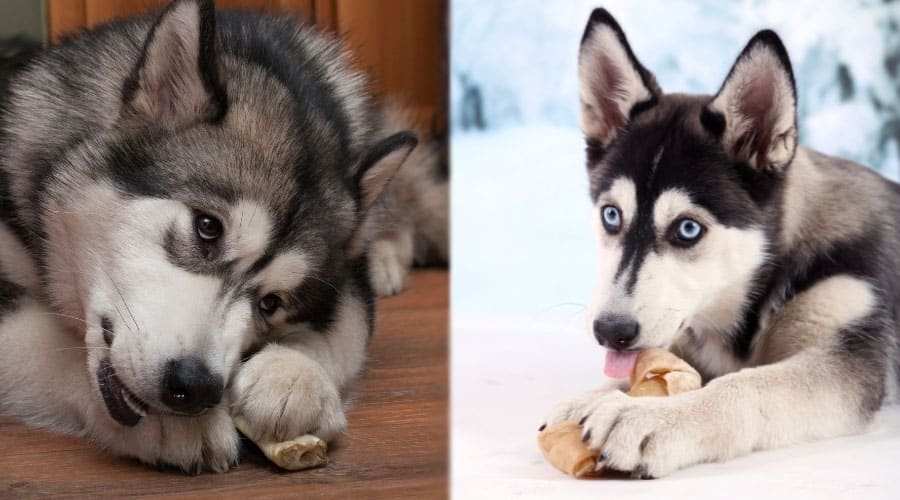
In terms of Nutrition, the Alaskan Malamute will consume four cups of food a day, whereas the Husky will consume three cups of food formulated specifically for active breeds like the Husky. This is generally dependant on size so if you have a large Husky and a small Malamute then they may consume the same.
As always, a good quality kibble is preferable to keep your pooch in tip-top condition. Be sure to keep an eye on the number of treats you feed them because despite them being active, they can definitely pile on the pounds quickly if it’s not monitored.
Grooming
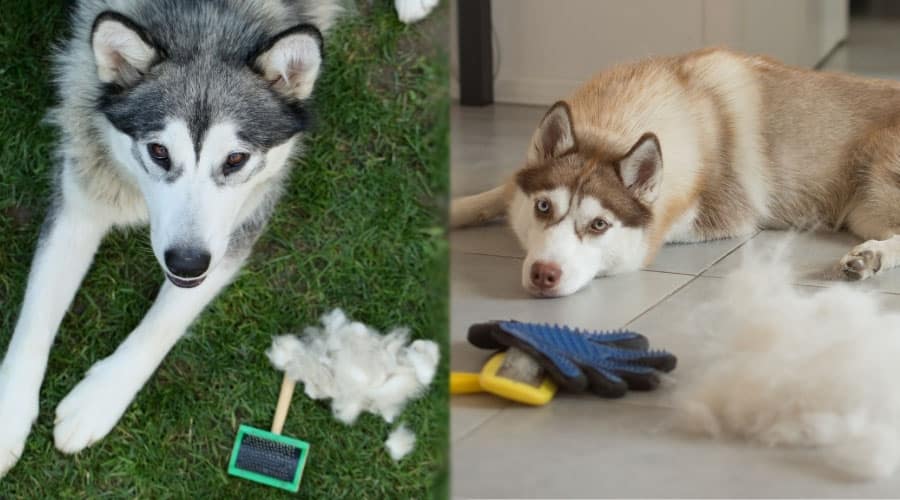
The grooming of the Alaskan Malamute and the Siberian Husky is identical. They both have a dense undercoat and a fluffy outer coat, and as such both breeds should be groomed at least two to three times a week, possibly more. During Springtime when the weather starts to become warmer, the Husky will shed heavily, and you can expect the same from the Malamute. Grooming will be required daily in order to keep their coat manageable for both you and your household.
Each dog should be bathed once a month, more often than this will damage the balance of the natural oils which keep their coat healthy, as well as drying their skin out. This can cause itchy flaky skin which will be very uncomfortable for them. As adventurous as they are, they will probably get dirty in between baths so they will also need a bit of a clean or sprucing up every week or so. You can do this with doggy wipes, doggy dry shampoo, and even doggy perfume that can be bought from your local pet store.
Additionally, because their undercoat is so dense, more so than any other dog, you need to ensure that after bathing their undercoat is fully rinsed and dried, otherwise, if this is not done properly there is a chance mold will grow on the fur very close to their skin. This can cause serious skin issues which will require medical treatment if left.
Both these guys are quite demanding compared to the average dog when it comes to grooming. Due to their incredibly dense coat, many Malamute and Husky owners say that during shedding seasons they take their pooches to a professional groomer because it can get unmanageable otherwise. If you don’t like a hairy house, then this is something to take into consideration.
Puppy Price
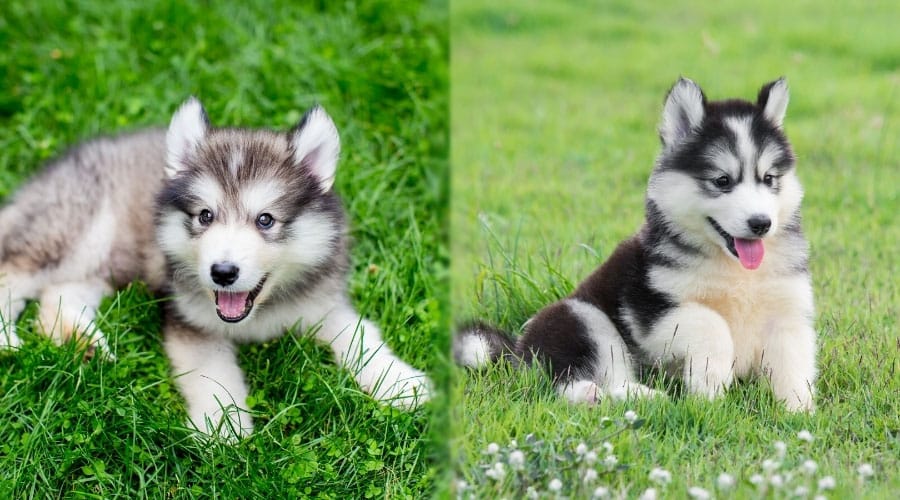
If you still can’t decide between the Alaskan Malamute and the Siberian Husky, then there is one last difference; the price. On average the Alaskan Malamute is priced at $1,500, whereas the Siberian Husky is priced at $1,000.
Of course, this can vary depending on certain desirable characteristics, the reputation of the breeder, the show-quality/bloodline of the dog, or the location of the breeder to name but a few. For example, if the pup has a rare coloring, or they have different colored eyes (known as heterochromia) then he is likely to be priced much higher than his siblings.
On top of the initial price, there are other costs to consider, such as the initial set-up of having a dog, such as beds, collars, ID tags, and toys, etc., as well as regular Veterinarian check-ups, medical insurance, the cost of his food, professional grooming, and many other things. Having a dog is a big commitment, and these guys cost a bit more than the average dog over the years.
Final Thoughts
Both of these guys are simply amazing and have both an impressive history and a remarkable working career. They really are the best of both canine words, hardworking intelligent pups who also shower you with love and affection when the job is done! They have many similarities but also many differences.
The Husky is predisposed to fewer health issues, requires less grooming, eats slightly less and the initial cost of him is cheaper. However, the Malamute is more independent, less likely to suffer from separation anxiety, and is more imposing and protective than the Husky.
They both need mega amounts of exercise and will destroy your house and garden if left unstimulated. However, they are both intelligent and pick up commands easily, so if you raise them correctly and maintain their needs, none of this should be an issue.
With their wolf-like appearance, but cuter and fluffier, they are head turners of both humans and other animals alike. The Malamute is much larger, and a better protector due to his guarding tendencies. So, if it is a guard dog you are after then the Malamute is probably the better option. The Husky is a smaller version, but much goofier and chattier than the Malamute. So, if it’s a friendly family friend you want, then maybe the Husky is the standout choice.
When it comes to choosing a canine companion, the question is never which dog is better, but which dog better suits you and your lifestyle? So, the million-dollar question is, which breed has pulled on your emotions and sledged straight into your heart?
